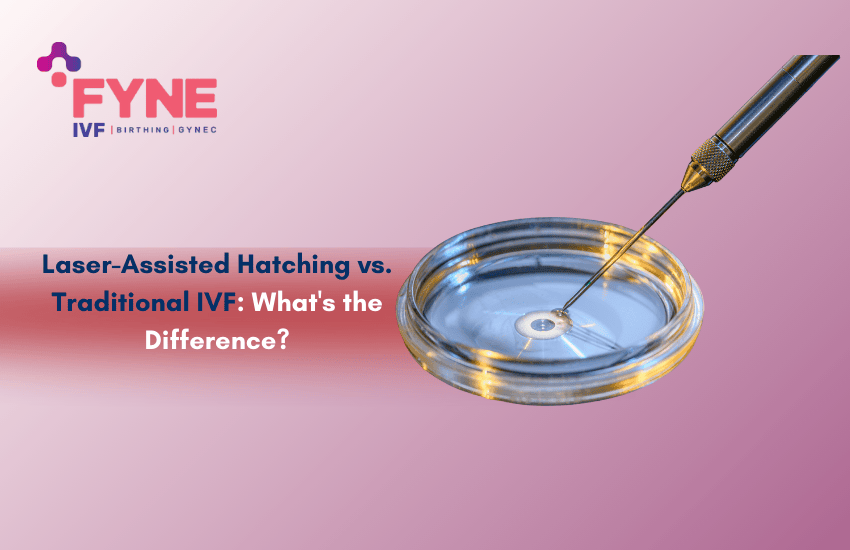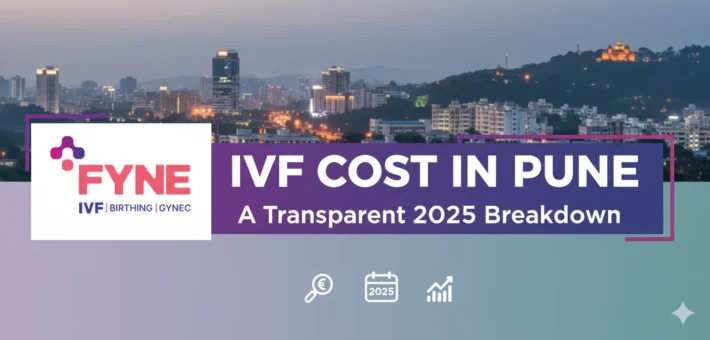Laser-Assisted Hatching vs. Traditional IVF: What’s the Difference?

For couples who have suffered repeated IVF failures, the emotional and physical toll can be overwhelming. While traditional IVF has helped many achieve successful pregnancies, it doesn’t work for everyone. Some couples face the challenge of embryo implantation failure despite having healthy embryos. This is where advanced techniques like Laser-Assisted Hatching (LAH) can make a difference.
In this blog, we’ll explain the differences between Laser-Assisted Hatching and Traditional IVF, how LAH works, its benefits, and when it might be right for you.
What Is Traditional IVF?
In-vitro Fertilisation (IVF) is a fertility treatment in which eggs are fertilised outside the body, and the resulting embryos are transferred into the uterus. The traditional IVF treatment procedure typically includes:
- Ovarian Stimulation: Hormonal medications are used to stimulate the ovaries to produce multiple eggs.
- Egg Retrieval: Once mature, the eggs are retrieved from the ovaries.
- Fertilisation: The eggs are fertilised with sperm, usually through insemination or ICSI (Intracytoplasmic Sperm Injection).
- Embryo Culture: The embryos are cultured in the lab for several days before transfer.
- Embryo Transfer: The healthiest embryos are selected and transferred into the woman’s uterus.
While IVF has a high success rate, it’s not always successful, especially for those who have had multiple failed IVF cycles. In cases of implantation failure, even when good-quality embryos are available, additional techniques like Laser-Assisted Hatching can help.
What Is Laser-Assisted Hatching?
Laser-assisted Hatching (LAH) is an advanced procedure that involves using a laser to create a small hole in the zona pellucida, which is the outer shell surrounding the embryo. This hole helps the embryo “hatch” and implant more easily into the uterine lining.
How Does It Work?
- LAH is performed on embryos that have reached the blastocyst stage (usually around day 5 of embryo development).
- The laser creates a controlled, precise opening in the zona pellucida, which can help embryos with difficulty hatching naturally by softening the shell or aiding the hatching process.
- This technique is designed to improve the chances of successful implantation in cases where embryos have not been successfully implanted in previous IVF cycles.
Laser-Assisted Hatching vs. Traditional IVF: Key Differences
While Traditional IVF is a standard treatment, Laser-Assisted Hatching is an additional technique used to help embryos implant more successfully. Here’s how the two compare:
Traditional IVF
- Procedure: Embryos are transferred into the uterus without assistance in the hatching process.
- Success Rates: Success depends on the embryo’s ability to hatch and implant on its own. IVF works well for many couples but not all, particularly when embryos have difficulty hatching or when there is an immune response that prevents implantation.
Laser-Assisted Hatching (LAH)
- Procedure: LAH involves creating a small opening in the embryo’s outer shell to aid in the hatching process and increase the chances of successful implantation.
- Success Rates: Studies show that LAH may improve success rates for couples who have struggled with recurrent IVF failures, particularly when embryos have a thick zona pellucida or low quality.
Key Differences
- IVF involves transferring embryos without additional assistance, while LAH specifically assists with embryo implantation.
- Laser-assisted Hatching may be used alongside traditional IVF if there are concerns about embryo hatching, increasing the likelihood of pregnancy.
Benefits of Laser-Assisted Hatching
- Increased Implantation Rates: By making it easier for embryos to hatch, LAH improves the chances of successful embryo implantation into the uterine lining.
- Aiding Older Women: For women over 35, who often have lower-quality eggs and thicker zona pellucida, LAH may significantly increase the chances of embryo survival and implantation.
- Helping Poor-Quality Embryos: Embryos that are good candidates for implantation but struggle to break free from their shell may benefit from LAH, improving their chances of a successful pregnancy.
Risks and Considerations of Laser-Assisted Hatching
Although Laser-Assisted Hatching has shown positive results in increasing pregnancy rates, there are some considerations:
- Potential Embryo Damage: If the laser is not applied carefully, it can damage the embryo. However, with experienced professionals, the risk of damage is minimal.
- Not for Everyone: LAH is not recommended for all IVF patients and is typically used in cases where repeated IVF failures have occurred.
When Should You Consider Laser-Assisted Hatching?
Laser-assisted Hatching is often considered for patients who have had:
- Multiple failed IVF cycles despite having good-quality embryos.
- Thick zona pellucida or embryos that are having difficulty hatching naturally.
- Advanced maternal age (35+), where the eggs may be more likely to have a thick shell that inhibits hatching.
Before opting for LAH, it’s essential to consult with your fertility specialist, who can assess whether it’s the right option for your IVF treatment plan.
In Conclusion
Understanding the differences between Laser-Assisted Hatching and Traditional IVF can help couples who have experienced repeated IVF failures find a new path to success. LAH can be a valuable tool in overcoming implantation difficulties and improving success rates, particularly for those who have struggled with recurrent pregnancy loss or failed IVF attempts.
By exploring advanced options like Laser-Assisted Hatching, you can make more informed decisions about your treatment and take proactive steps towards achieving your dream of parenthood.
Empower Your Fertility Journey at FYNE IVF
If you’ve experienced multiple IVF failures and are wondering whether Laser-Assisted Hatching could improve your chances of success, visit FYNE IVF. Our expert fertility team, led by Dr. Deepali Chinchole, specialises in advanced IVF techniques like LAH to help couples achieve their dream of parenthood. Book a Consultation and explore how we can help you with your IVF journey.
FAQs
1. What is Laser-Assisted Hatching (LAH)?
A: Laser-assisted Hatching is a procedure where a laser creates a small hole in the embryo’s outer shell, facilitating the embryo’s ability to implant in the uterus.
2. How does LAH improve IVF success rates?
A: LAH helps embryos hatch and implant more easily by making a controlled hole in the zona pellucida, which can lead to better chances of successful pregnancy, especially for women who’ve had multiple IVF failures.
3. Is LAH necessary for all IVF patients?
A: No, Laser-Assisted Hatching is not required for every IVF patient. It is typically recommended for those with recurrent IVF failures or issues with embryo hatching, particularly for women of advanced age.
4. Does LAH increase the cost of IVF treatment?
A: Yes, Laser-Assisted Hatching adds to the cost of an IVF cycle. The procedure is an additional step to improve implantation chances, but it can be a worthwhile investment for those who have struggled with IVF failures.
5. Are there any risks associated with Laser-Assisted Hatching?
A: While LAH is generally safe, there is a slight risk of embryo damage if not performed accurately. However, this risk is very low when performed by an experienced professional.
